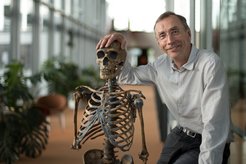Körber European Science Prize for Svante Pääbo
The director at the Max Planck Institute for Evolutionary Anthropology in Leipzig is honoured for his pioneering achievements in the field of paleogenetics today, of which he is regarded as one of the founders
The Körber Prize for European Science 2018 will be presented to Svante Pääbo on September 7 in the Great Festival Hall of Hamburg City Hall. With 750,000 euros, it is one of the world's highest endowed research prizes. One of Svante Pääbo's most important scientific achievements is the decoding of the Neanderthal genome. According to the jury, his work has revolutionised our understanding of the evolutionary history of modern humans. For example, he has shown that Neanderthals and other extinct hominids have made a significant contribution to the ancestry of modern man.

Svante Pääbo, 63, studied Egyptology and Medicine at Uppsala University. As a postgraduate, writing his PhD in immunology, he also demonstrated that DNA can survive in ancient Egyptian mummies and thus gained professional fame as a pioneer in the new field of palaeogenetics. Palaeogeneticists study the genomes of ancient organisms and draw conclusions about the course of evolution.
After completing his doctorate, Pääbo worked in the team of evolutionary biologist Allan Wilson at the University of California in Berkeley. From 1990 he headed his own laboratory at the Ludwig Maximilian University of Munich. In 1997 Pääbo became one of five directors at the newly founded Max Planck Institute for Evolutionary Anthropology in Leipzig, where he is still active.
Already in the mid-1990s, Pääbo and his team were able to decipher a relatively short part of mitochondrial DNA of a Neanderthal. Mitochondria are tiny power plants in the cells that supply them with energy and have their own DNA. This DNA of the Neanderthals differed significantly from that of today's humans showing that Neanderthals were not the direct ancestors of current humans.
One gigantic puzzle
As DNA sequencing techniques became much more efficient in the early 2000s, Pääbo decided to try to sequence the complete Neanderthal genome that is present in cell nuclei. However, after millennia in the ground their bones are so heavily populated by bacteria and fungi that up to 99.9 percent of the DNA found in them comes from microbes. In addition, the small amounts of remaining Neanderthal DNA is broken down into short fragments that have to be put together like a gigantic puzzle. Many scientists believed that this task was impossible.
However, Pääbo’s team again and again came up with new solutions to the many problems they encountered. The researchers worked under "clean room conditions" akin to those in the chip industry to prevent them from inadvertently introducing their own DNA to the experiments and they developed more efficient extraction methods that improved the yield of Neanderthal DNA. They also wrote complex computer programs, which compared the DNA snippets from the ancient bones with reference genomes of chimpanzees and humans to reconstruct the Neanderthal genome.
In 2010, Pääbo’s team succeeded in reconstructing a first version of the genome of Neanderthals from bones that are tens of thousands of years old. Comparisons of the Neanderthal genome with the genomes of present-day humans he showed that modern humans and Neanderthals produced joint offspring when they met some 50,000 years ago when modern humans left Africa and arrived in Europe and Asia. Consequently, the genomes of people outside Africa today contain about 2 percent Neanderthal DNA. This genetic contribution had positive effects, for example in that it helped strengthen the immune system of modern humans but it also contributes to susceptibility to several diseases today. "Neanderthals are the closest relatives of present-day people," says Pääbo. "Comparisons of their genomes with those of humans today and with apes allows us to determine when genetic changes occurred in our ancestors." In the future, this could help clarify why modern humans eventually developed complex culture and technology that allowed them to colonize almost the entire world. However, this requires a more complete knowledge about the Neanderthal genome than the team had achieved in 2010.
A Heruclean task
By 2014, the team had finally completed the Herculean task of almost completely decoding the Neanderthal genome, allowing it to be compared to the genomes of people today. "We found about 30,000 positions at which the genomes of almost all present-day people differ from those of Neanderthals as well as the apes," says Pääbo. "They answer what makes anatomically modern people 'modern' in the genetic sense." Some of these genetic changes may be the key to understanding what sets the cognitive abilities of modern humans apart from other now extinct hominins.
In 2012, Svante Pääbo’s team achieved another sensation: they decoded the genome of from a small bone found in the Denisova Cave in the Altai Mountains in Western Siberia and found that it came from a previous unknown hominin group which they called “Denisovans”. Denisovans were distantly related to Neanderthals and contributed up to five percent to the genome of today's inhabitants of Papua New Guinea, Aboriginal Australians and other groups in Oceania.
DNA from hot and humid regions
Currently, the researchers work on methods to retrieve DNA fragments that are even more degraded, and present in even smaller amounts, than what is currently possible. They goal is to make it possible for scientists to study even older DNA, and old DNA from parts of the world where a hot and humid climate make the DNA survival even more rare.
The Körber European Science Prize 2018 will be presented to Svante Pääbo on 7 September in the Great Festival Hall of Hamburg City Hall. With prize money of 750,000 euros it is one of the world's most highly endowed prizes. Every year since 1985, the Körber-Stiftung has honoured a major breakthrough in the physical or life sciences in Europe. The prize is awarded to excellent and innovative research approaches with high application potential. To date, six prize winners have also been awarded the Nobel Prize after receiving the Körber Prize.












